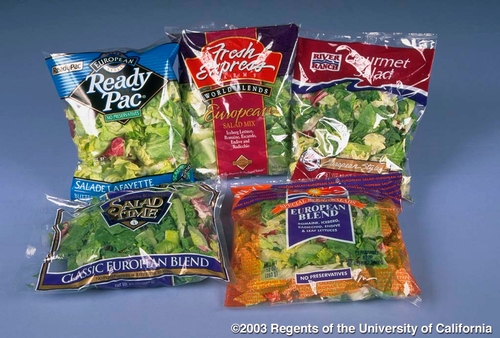E. coli outbreak on lettuce parallels recent
UC research development
Although the outbreak earlier this month of E. coli O145 in shredded Romaine lettuce hasn’t touched California consumers and local retailers, it is impacting the industry. Once again, the safety of pre-washed and cut leafy vegetables are in headlines, raising the fears of consumers and producers alike.
The Centers for Disease Control have confirmed 23 illnesses and 7 probable illnesses in New York, Michigan, Ohio and Tennessee from the contaminated lettuce. The traceback investigation is stretching west to Yuma, Ariz., where the lettuce may have been grown. So far, the source of the contamination has not been identified.
A source of confusion and alarm, however, is the contaminant’s O145 designation. For the past 30 years, the majority of the E. coli illness outbreaks in America were serotype O157:H7. UC Davis Cooperative Extension produce safety specialist Trevor Suslow said E. coli O145 doesn’t come completely out of the blue. O145 is recognized in its association with food in other countries and more often with animal products, not produce.
Suslow and his staff were well aware of E. coli O145 prior to this month’s outbreak and included it in their recent research aimed at development of a new method for detecting a broad range of the most dangerous E. coli bacteria in produce and produce production environments.
The new test was not designed to identify a particular strain of E. coli, but to determine whether a pathogenic/toxigenic strain of E. coli – such as O145 – is present. If the test comes up positive, a secondary test can be conducted to narrow down the specific type of E.coli.
Pathogenic/toxigenic E. coli are of tremendous concern for the fresh produce industry. “Generic” E. coli live in the guts of most mammals; they are typically harmless and may even be beneficial. However, pathogenic/toxigenic E. coli, when ingested by humans, can cause bloody diarrhea and, particularly in the very young and very old, may lead to kidney failure and even death.
Suslow said the new test, which goes by the working name “total pathogenic E. coli,” or TPEC, was tested in a variety of different types of samples: irrigation water, feed lot surface material, manure, compost, soil and produce.
“With all those materials, we had very good effectiveness, but especially with water and produce,” Suslow said.
The research will be presented at the UC Davis Center for Produce Safety Produce Research Symposium on June 23. The Produce Research Symposium is open to the public. A $150 registration fee includes all symposium sessions, breakfast, lunch and an evening reception in the courtyard and gardens of the Robert Mondavi Institute for Wine and Food Science.
For more information or to register for the symposium, see the Center for Produce Safety website at http://cps.ucdavis.edu.

Bagged lettuce was implicated in a recent food safety outbreak.
